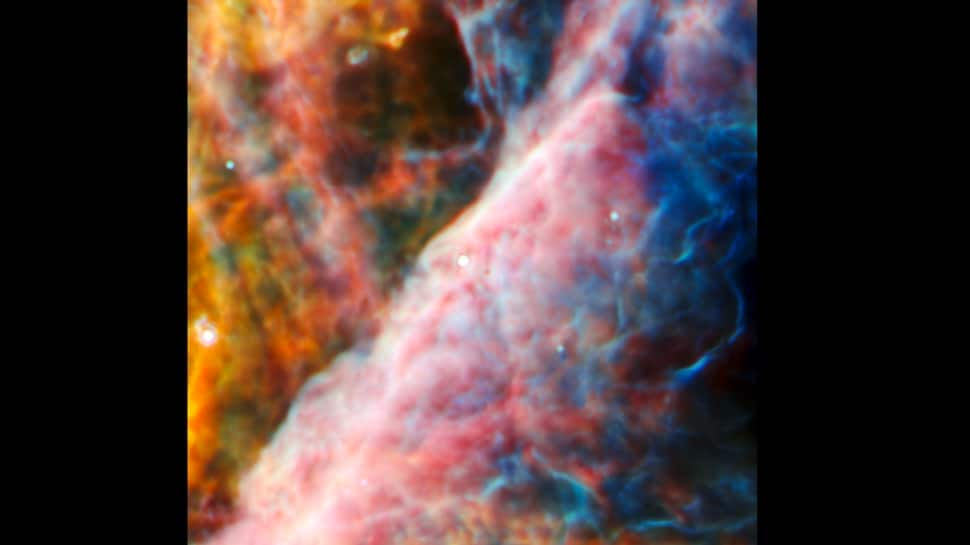Life In Space? NASA Makes Stunning First-Ever Discovery Of Crucial Carbon Molecule In Space
NASA added that Carbon compounds form the foundations of all known life, and as such are particularly interesting to scientists working to understand both how life developed on Earth, and how it could potentially develop elsewhere in our universe.
Trending Photos
) Marie-Aline Martin-Drumel of the University of Paris-Saclay in France, a member of the science team, said that this detection not only validates the incredible sensitivity of Webb but also confirms the postulated central importance of CH3+ in interstellar
Marie-Aline Martin-Drumel of the University of Paris-Saclay in France, a member of the science team, said that this detection not only validates the incredible sensitivity of Webb but also confirms the postulated central importance of CH3+ in interstellar In yet another breakthrough that symbolizes the existence of life in the universe, the National Aeronautics and Space Administration (NASA) has made a stunning discovery of a carbon molecule that is said to be the foundation for all known life. The discovery was made by NASA's James Webb Space Telescope. The international space agency revealed this in its latest website post.
"A team of international scientists has used NASA’s James Webb Space Telescope to detect a new carbon compound in space for the first time. Known as methyl cation (pronounced cat-eye-on) (CH3+), the molecule is important because it aids the formation of more complex carbon-based molecules. Methyl cation was detected in a young star system, with a protoplanetary disk, known as d203-506, which is located about 1,350 light-years away in the Orion Nebula," said NASA.
Scientists using @NASAWebb have detected a crucial carbon compound in space for the first time. Known as methyl cation (pronounced cat-eye-on), it’s thought to aid in building more complex carbon molecules—the foundation for all known life: https://t.co/QVLCDQjCi8 pic.twitter.com/q9Hy0ZgXbt — NASA (@NASA) June 26, 2023
It further added that Carbon compounds form the foundations of all known life, and as such are particularly interesting to scientists working to understand both how life developed on Earth, and how it could potentially develop elsewhere in our universe. "The study of interstellar organic (carbon-containing) chemistry, which Webb is opening in new ways, is an area of keen fascination to many astronomers," said NASA.
Explaining the James Webb Telescope's role in the discovery, NASA said, "The unique capabilities of Webb made it an ideal observatory to search for this crucial molecule. Webb’s exquisite spatial and spectral resolution, as well as its sensitivity, all contributed to the team’s success. In particular, Webb’s detection of a series of key emission lines from CH3+ cemented the discovery."

Marie-Aline Martin-Drumel of the University of Paris-Saclay in France, a member of the science team, said that this detection not only validates the incredible sensitivity of Webb but also confirms the postulated central importance of CH3+ in interstellar chemistry.
"While the star in d203-506 is a small red dwarf, the system is bombarded by strong ultraviolet (UV) light from nearby hot, young, massive stars. Scientists believe that most planet-forming disks go through a period of such intense UV radiation since stars tend to form in groups that often include massive, UV-producing stars," said NASA.
NASA said that typically, UV radiation is expected to destroy complex organic molecules and that is why the discovery of CH3+ might seem to be a surprise. "However, the team predicts that UV radiation might actually provide the necessary source of energy for CH3+ to form in the first place. Once formed, it then promotes additional chemical reactions to build more complex carbon molecules. Broadly, the team notes that the molecules they see in d203-506 are quite different from typical protoplanetary disks. In particular, they could not detect any signs of water," said NASA.
Stay informed on all the latest news, real-time breaking news updates, and follow all the important headlines in india news and world News on Zee News.
Live Tv







)
)
)
)
)
)
)
)
)
)
